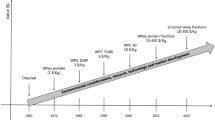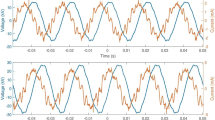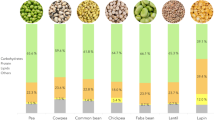Abstract
Peanut protein is widely consumed in many countries of the world. The effects of transglutaminase (TGase)-induced cross-linking on the functional properties of peanut protein fractions of arachin and conarachin were investigated. TGase promoted protein cross-linking and caused lower protein solubility. SDS-PAGE and high-performance size exclusion chromatography displayed that larger polymers or aggregates were formed during TGase treatment and the conarachin fraction was more susceptible to cross-linking than arachin. Conarachin has higher surface hydrophobicity (H 0) and emulsifying properties than arachin. TGase incubation led to decrease in total free SH content and increase in exposed SH and H 0 before 90 min treatment, suggesting unfolding of the protein molecules. The emulsifying properties for conarachin were also progressively improved by TGase treatment before 90 min, which was consistent with the change of H 0. This study presented the variance in structure and emulsifying properties changes between arachin and conarachin fractions and their functional properties change caused by TGase cross-linking.






Similar content being viewed by others
References
Wu HW, Wang Q, Ma TZ, Ren JJ (2009) Comparative studies on the functional properties of various protein concentrate preparations of peanut protein. Food Res Int 42(3):343–348
He XH, Liu HZ, Liu L, Zhao GL, Wang Q, Chen QL (2014) Effects of high pressure on the physicochemical and functional properties of peanut protein isolates. Food Hydrocoll 36:123–129
Colombo A, Ribotta PD, León AE (2010) Differential scanning calorimetry (DSC) studies on the thermal properties of peanut proteins. J Agric Food Chem 58(7):4434–4439
Martins IM, Matos M, Costa R, Silva F, Pascoal A, Estevinho LM, Choupina AB (2014) Transglutaminases: recent achievements and new sources. Appl Microbiol Biotechnol 98(16):6957–6964
Gauche C, Barreto PL, Bordignon-Luiz MT (2010) Effect of thermal treatment on whey protein polymerization by transglutaminase: implications for functionality in processed dairy foods. LWT Food Sci Technol 43(2):214–219
Jiang S-J, Zhao X-H (2010) Transglutaminase-induced cross-linking and glucosamine conjugation in soybean protein isolates and its impacts on some functional properties of the products. Eur Food Res Technol 231(5):679–689
Wang JS, Zhao MM, Yang XQ, Jiang YM, Cui C (2007) Gelation behavior of wheat gluten by heat treatment followed by transglutaminase cross-linking reaction. Food Hydrocoll 21(2):174–179
Lorenzen PC (2007) Effects of varying time/temperature-conditions of pre-heating and enzymatic cross-linking on techno-functional properties of reconstituted dairy ingredients. Food Res Int 40(6):700–708
Jiang Y, Tang CH, Wen QB, Li L, Yang XQ (2007) Effect of processing parameters on the properties of transglutaminase-treated soy protein isolate films. Innov Food Sci Emerg Technol 8(2):218–225
Hu X, Zhao MM, Sun WZ, Zhao GL, Ren JY (2011) Effects of microfluidization treatment and transglutaminase cross-linking on physicochemical, functional, and conformational properties of peanut protein isolate. J Agric Food Chem 59(16):8886–8894
Qiu CY, Sun WZ, Zhao QZ, Cui C, Zhao MM (2013) Emulsifying and surface properties of citric acid deamidated wheat gliadin. J Cereal Sci 58(1):68–75
Zhao GL, Liu Y, Zhao MM, Ren JY, Yang B (2011) Enzymatic hydrolysis and their effects on conformational and functional properties of peanut protein isolate. Food Chem 127(4):1438–1443
Feng XL, Liu HZ, Shi AM, Liu L, Wang Q, Adhikari B (2014) Effects of transglutaminase catalyzed crosslinking on physicochemical characteristics of arachin and conarachin-rich peanut protein fractions. Food Res Int 62:84–90
Tang CH, Wu H, Chen Z, Yang XQ (2006) Formation and properties of glycinin-rich and β-conglycinin-rich soy protein isolate gels induced by microbial transglutaminase. Food Res Int 39(1):87–97
Church FC, Swaisgood HE, Porter DH, Catignani GL (1983) Spectrophotometric assay using o-phthaldialdehyde for determination of proteolysis in milk and isolated milk proteins. J Dairy Sci 66(6):1219–1227
Lowry OH, Rosebrough NJ, Farr AL, Randall RJ (1951) Protein measurement with the Folin phenol reagent. J Biol Chem 193(1):265–275
Laemmli UK (1970) Cleavage of structural proteins during the assembly of the head of bacteriophage T4. Nature 227(5259):680–685
Haskard CA, Li-Chan EC (1998) Hydrophobicity of bovine serum albumin and ovalbumin determined using uncharged (PRODAN) and anionic (ANS-) fluorescent probes. J Agric Food Chem 46(7):2671–2677
Beveridge T, Toma SJ, Nakai S (1974) Determination of SH-and SS-groups in some food proteins using ellman’s reagent. J Food Sci 39(1):49–51
Keowmaneechai E, McClements D (2002) Influence of EDTA and citrate on physicochemical properties of whey protein-stabilized oil-in-water emulsions containing CaCl2. J Agric Food Chem 50(24):7145–7153
Motoki M, Seguro K (1998) Transglutaminase and its use for food processing. Trends Food Sci Technol 9(5):204–210
Chiou RYY (1990) Effects of heat treatments on peanut arachin and conarachin. J Food Biochem 14(3):219–232
Gharst GA (2007) Biochemical and rheological characterization of peanut proteins crosslinked with microbial transglutaminase. PhD Dissertation. North Carolina State University, Carolina, America
Mohamed A, Biresaw G, Xu J, Hojilla-Evangelista MP, Rayas-Duarte P (2009) Oats protein isolate: thermal, rheological, surface and functional properties. Food Res Int 42(1):107–114
Kato A, Tsutsui N, Matsudomi N, Kobayashi K, Nakai S (1981) Effects of partial denaturation on surface properties of ovalbumin and lysozyme. Agric Biol Chem 45(12):2755–2760
Færgemand M, Otte J, Qvist KB (1998) Emulsifying properties of milk proteins cross-linked with microbial transglutaminase. Int Dairy J 8(8):715–723. doi:10.1016/S0958-6946(98)00111-3
Tang CH, Sun X, Yin SW, Ma CY (2008) Transglutaminase-induced cross-linking of vicilin-rich kidney protein isolate: influence on the functional properties and in vitro digestibility. Food Res Int 41(10):941–947
Siu NC, Ma CY, Mock WY, Mine Y (2002) Functional properties of oat globulin modified by a calcium-independent microbial transglutaminase. J Agric Food Chem 50(9):2666–2672
Marcoa C, Rosell CM (2008) Effect of different protein isolates and transglutaminase on rice flour properties. J Food Eng 84(1):132–139
Tang CH, Yang XQ, Chen Z, Wu H, Peng Z (2005) Physicochemical and structural characteristics of sodium caseinate biopolymers induced by microbial transglutaminase. J Food Biochem 29(4):402–421
Acknowledgements
The authors gratefully acknowledge the financial support obtained from Chinese National Natural Science Fund (31601503 and 31301454), Special fund for basic scientific research business of Central Public Research Institutes (2015TS29), the Fundamental Research Funds for the Central Universities (201616308) and Open fund of Key Laboratory of Aquatic Products Processing of Ministry of Agriculture (NYJG201511).
Author information
Authors and Affiliations
Corresponding author
Ethics declarations
Conflict of interest
The authors declare no conflict of interest.
Compliance with ethics requirements
This article does not contain any studies with human or animal subjects.
Rights and permissions
About this article
Cite this article
Qiu, C., Hu, X., Li, L. et al. Effect of transglutaminase cross-linking on the conformational and emulsifying properties of peanut arachin and conarachin fractions. Eur Food Res Technol 243, 913–920 (2017). https://doi.org/10.1007/s00217-016-2804-z
Received:
Revised:
Accepted:
Published:
Issue Date:
DOI: https://doi.org/10.1007/s00217-016-2804-z




